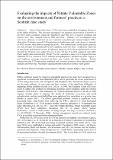Evaluating the impacts of Nitrate Vulnerable Zones on the environment and on farmers’ practices: a Scottish case study
Abstract
Nitrate vulnerable zones (NVZs) have been established throughout Europe to tackle diffuse pollution. This research investigates the attitudes and practices of farmers in the River Eden catchment, within the Strathmore and Fife NVZ in eastern Scotland, and explores how these changed between 2002 and 2011. Attitudes were investigated using interviews; efficiency of nutrient use was evaluated using farm gate nutrient budgets (NBs). Most of the 16 farmers regard NVZ regulations as burdensome and costly; however, attitudes to NVZs became more positive during the period. NBs demonstrated that arable farms generate the least nitrogen (N) and phosphorus (P) surpluses, dairy the most. N efficiency improved on nine farms and declined on two; P efficiency improved on 12 farms and declined on two. Overall, the 16 farms were using 13% less N and 19% less P in 2011 compared with 2003. Water quality data demonstrate that Nitrate N in the catchment's main rivers dropped between 2004 and 2011 by a mean of 15.5%, whereas mean phosphate P declined very little. Legacy P and Inefficient sewerage treatment facilities may explain the latter finding. Results demonstrate that NVZ regulations, combined with economic pressures, have affected farmers’ attitudes and behaviour, resulting in significant improvements in surface water quality.
Citation
Macgregor , C & Warren , C R 2016 , ' Evaluating the impacts of Nitrate Vulnerable Zones on the environment and on farmers’ practices: a Scottish case study ' , Scottish Geographical Journal , vol. 132 , no. 1 , pp. 1-20 . https://doi.org/10.1080/14702541.2015.1034760
Publication
Scottish Geographical Journal
Status
Peer reviewed
ISSN
1470-2541Type
Journal article
Description
The research work associated with the 2011 study was supported by the Co-operative Research Programme of the OECD [grant number JA708774].Collections
Items in the St Andrews Research Repository are protected by copyright, with all rights reserved, unless otherwise indicated.

